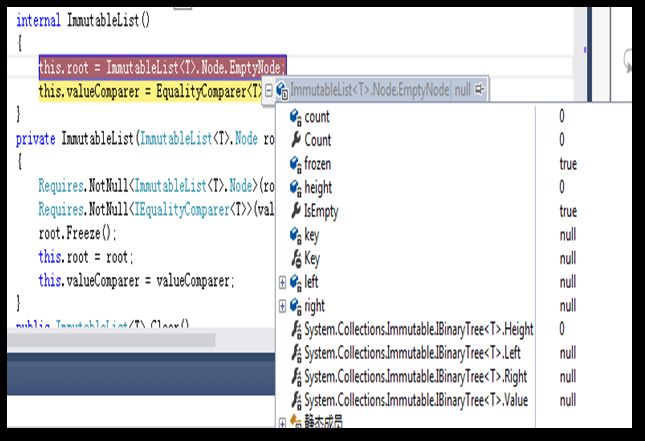Immutable Collections(2)ImmutableList实现原理.(上)
文/玄魂
前言
在上一篇文章(Immutable Collections(1)),我简要说明了不可变集合的基本概念和简单应用。从本篇博文开始,会探讨下几个典型集合类型的内部实现机制。本篇博客主要探讨ImmutableList<T>实现原理。
博文中引用的代码并非是.NET源码,而是反编译得来,不正确之处,还望指教。
2.1 概述
下图是ImmutableList<T>类型包含的核心字段、属性(并非全部),以及和其他类型的关系。这张图是自动生成的,我直接拿过来没有做什么改动,可能会让人云里雾里,下面我做简要的说明。

处于最顶端的ImmutableList静态类,是ImmutableList<T>类型的构造者,它或者直接返回ImmutableList<T>的Empty属性,或者在Empty的基础上构造ImmutableList<T>实例,比如下面的代码:
public static ImmutableList<T> Create<T>()
{
return ImmutableList<T>.Empty;
}
public static ImmutableList<T> Create<T>(IEqualityComparer<T> equalityComparer)
{
return ImmutableList<T>.Empty.WithComparer(equalityComparer);
}
public static ImmutableList<T> Create<T>(T item)
{
return ImmutableList<T>.Empty.Add(item);
}
ImmutableList静态类下面是核心部分——ImmutableList<T>类型。ImmutableList<T>继承自如下接口:
IImmutableList<T>, IReadOnlyList<T>, IReadOnlyCollection<T>, IList<T>, ICollection<T>, IList, ICollection, IOrderedCollection<T>, IEnumerable<T>, IEnumerable, IImmutableListQueries<T>
其中IImmutableList<T>定义如下:
public interface IImmutableList<T> : IReadOnlyList<T>, IReadOnlyCollection<T>, IEnumerable<T>, IEnumerable
{
IEqualityComparer<T> ValueComparer
{
get;
}
IImmutableList<T> Clear();
bool Contains(T value);
int IndexOf(T value);
IImmutableList<T> Add(T value);
IImmutableList<T> AddRange(IEnumerable<T> items);
IImmutableList<T> Insert(int index, T element);
IImmutableList<T> InsertRange(int index, IEnumerable<T> items);
IImmutableList<T> Remove(T value);
IImmutableList<T> RemoveAll(Predicate<T> match);
IImmutableList<T> RemoveRange(IEnumerable<T> items);
IImmutableList<T> RemoveRange(int index, int count);
IImmutableList<T> RemoveAt(int index);
IImmutableList<T> SetItem(int index, T value);
IImmutableList<T> Replace(T oldValue, T newValue);
IImmutableList<T> WithComparer(IEqualityComparer<T> equalityComparer);
}
IImmutableListQueries<T>定义如下:
internal interface IImmutableListQueries<T>
{
int Count
{
get;
}
ImmutableList<TOutput> ConvertAll<TOutput>(Func<T, TOutput> converter);
void ForEach(Action<T> action);
ImmutableList<T> GetRange(int index, int count);
void CopyTo(T[] array);
void CopyTo(T[] array, int arrayIndex);
void CopyTo(int index, T[] array, int arrayIndex, int count);
bool Exists(Predicate<T> match);
T Find(Predicate<T> match);
ImmutableList<T> FindAll(Predicate<T> match);
int FindIndex(Predicate<T> match);
int FindIndex(int startIndex, Predicate<T> match);
int FindIndex(int startIndex, int count, Predicate<T> match);
T FindLast(Predicate<T> match);
int FindLastIndex(Predicate<T> match);
int FindLastIndex(int startIndex, Predicate<T> match);
int FindLastIndex(int startIndex, int count, Predicate<T> match);
int IndexOf(T item);
int IndexOf(T item, int index);
int IndexOf(T item, int index, int count);
int LastIndexOf(T item);
int LastIndexOf(T item, int index);
int LastIndexOf(T item, int index, int count);
bool TrueForAll(Predicate<T> match);
}
其他接口,是.NET中原有接口,这里就不列举了。IImmutableList<T> 的核心行为都定义在这两个接口当中。
SyncRoot是Object类型字段,作为同步锁对象。
Empty直接返回当前集合的单例对象EmptySingleton。

ImmutableList<T>构造函数如下:
internal ImmutableList()
{
this.root = ImmutableList<T>.Node.EmptyNode;
this.valueComparer = EqualityComparer<T>.Default;
}
private ImmutableList(ImmutableList<T>.Node root, IEqualityComparer<T> valueComparer)
{
root.Freeze();
this.root = root;
this.valueComparer = valueComparer;
}
在构造函数中我们又发现两个很重要的类型,Node和IEqualityComparer。IEqualityComparer这里就不解释了,我们重点关注Node,从字面上理解,这是一个表示节点的类,事实上它是ImmutableList<T>的核心,数据的承载和操作都是对Node类的包装。下面我们来看看Node的庐山真面目。
2.2 Node
Node类继承自三个接口,
internal sealed class Node : IBinaryTree<T>, IEnumerable<T>, IEnumerable
我们主要关注IBinaryTree<T>,定义如下:
interface IBinaryTree<out T>
{
int Height
{
get;
}
T Value
{
get;
}
IBinaryTree<T> Left
{
get;
}
IBinaryTree<T> Right
{
get;
}
bool IsEmpty
{
get;
}
int Count
{
get;
}
}
接口很清楚,定义了一个二叉树,但是这棵二叉树的具体特性但从接口上还无从得知。现在我们再看Node类。

ImmutableList<T>的EmptySingleton就是返回的上图中最上面的Node类的EmptyNode。EmptyNode定义如下:
internal static readonly Node EmptyNode = new Node();
Node类的Key和Value属性是同一个值,就是当前节点的值。在代码中都是以Key为操作对象。下面分析Node的相关行为的时候,会有更清楚的认识。
frozen是一个bool类型的变量,表示是否冻结。冻结可以说是不可变集合的一个关键特性,下面也会对此做详细的分析。
height是以当前节点为根的树的高度。
this.height = 1 + Math.Max(left.height, right.height);
count以当前节点为根的树的节点个数。
this.count = 1 + left.count + right.count;
IsEmpty判断是否有子节点。
public bool IsEmpty
{
get
{
return this.left == null;
}
}
right和left就是左右子树。
2.3 行为
2.3.1 初始化
我们通过下面的代码来观察Node的初始化过程。
static void Main(string[] args)
{
var fruitBasket = ImmutableList.Create<string>();
var ass = fruitBasket.Add("ddd");
}
启动程序,首先进入ImmutableList.Create<string>()方法。

Create方法直接返回ImmutableList<T>.Empty,Empty属性直接返回EmptySingleton。

调用EmptySingleton时触发ImmutableList<T>的初始化。

接下来在构造函数中调用Node.EmptyNode。


在Node类的无参构造函数中只初始化了一个变量:

此时Node.EmptyNode实例的各字段值如下图所示:

到此为止第一次初始化结束。
现在测试下带比较器的构造方式,先新建一个TestCompare类:
class TestCompare<T> : IEqualityComparer<T>
{
public bool Equals(T x, T y)
{
return x.Equals(y);
}
public int GetHashCode(T obj)
{
return this.GetHashCode();
}
}
然后更改Main函数中的代码:
static void Main(string[] args)
{
var fruitBasket = ImmutableList.Create<string>(new TestCompare<string>());
var ass = fruitBasket.Add("ddd");
}
ImmutableList静态方法仍然在ImmutableList<T>.Empty基础上调用了WithCompare方法。

WithCompare方法在初始化了valueCompare字段之后调用了构造函数ImmutableList(ImmutableList<T>.Node root, IEqualityComparer<T> valueComparer):
private ImmutableList(ImmutableList<T>.Node root, IEqualityComparer<T> valueComparer)
{
Requires.NotNull<ImmutableList<T>.Node>(root, "root");
Requires.NotNull<IEqualityComparer<T>>(valueComparer, "valueComparer");
root.Freeze();
this.root = root;
this.valueComparer = valueComparer;
}
上面的构造函数,调用了Freeze()方法,
internal void Freeze()
{
if (!this.frozen)
{
this.left.Freeze();
this.right.Freeze();
this.frozen = true;
}
}
这段代码,实际上是一个递归调用,设置每个节点为冻结状态。
带初始值的构造函数,实际是调用了Add方法,我将在下一篇博文中单独分析。
本篇博文到此结束,未完,待续。。。。。。